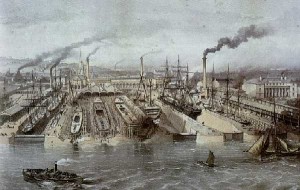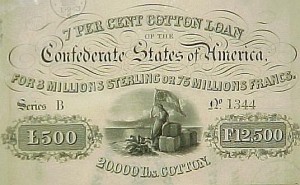John Laird Sons / Birkenhead Iron Works (Frank Leslie’s 1864)
“It is very seldom that a particular name is given to a ship until at or about the time of her launch, but [instead] a dockyard number is assigned to her. . . . The number given to the ship contracted for with Messrs. Laird was ‘290,’ which, it will be perceived, had none of the mysterious significance so often ascribed to it, but meant simply that she was the 290th ship built by them.”
— James D. Bulloch, The Secret Service of the Confederate States in Europe
James D. Bulloch, a former US Navy officer, arrived in England on June 4, 1861 as a principal agent of the newly formed Confederate States navy. Among his critical tasks was securing, by purchase or construction, vessels of war that could be sent to destroy northern merchant ships and the cargoes they carried.
British law, however, proscribed any “arming” or “equipping” of a vessel for hostile purposes if the hostility was directed against a country Britain was not at war with. In 1861, Britain was not at war with the United States; so the Confederacy could not lawfully arm and equip a warship in Britain for use against the US.
Bulloch was undeterred. After legal maneuvering, on August 1, 1861 he entered into a contract with the shipbuilders John Laird Sons of the Birkenhead Iron Works, located across the Mersey River from Liverpool. The contract called for the construction of a “Wooden Screw Steam Vessel” that would eventually become the CSS Alabama, the single most destructive vessel built by either side in the Civil War.
The ship was never named until her launch, and even then she was not the “Alabama.” The number 290 may not have been inherently mysterious, but the use of that number in lieu of a name was an integral part of a determined Confederate effort at deception. As Bulloch’s memoirs make clear, 290 was always destined to be “armed” and “equipped” for use against the Union. When her career concluded in 1864, the CSS Alabama had burned or bonded 65 federal vessels, including one US Navy warship. The post-war estimate of damage done to northern interests was $6.5 million – about $100 million in today’s dollars. It was a singular achievement for a solitary vessel.



